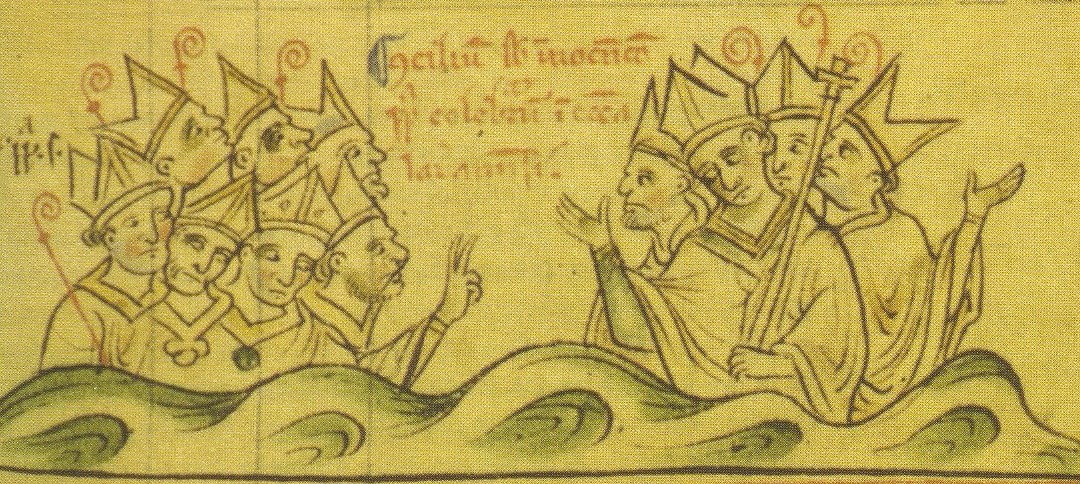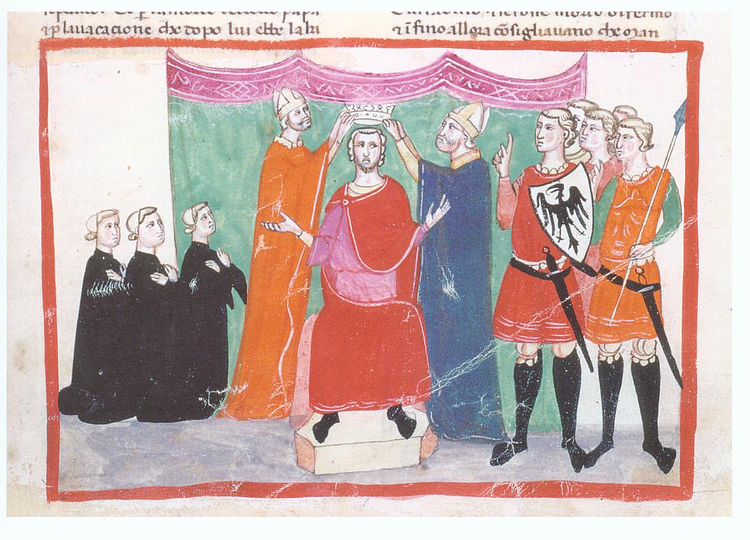05 Popes, Politics, Emperors: from Lateran IV to Avignon
two superpowers: Pope and Holy Roman Emperor (plus monarchies)
Latin Europe becomes more Christian in practice, with increasing importance of central Church
The pope has too many jobs:
- Center of legitimizing many other European powers
- Ruler of central Italy—a parallel to kings
- Ruler of Rome (in competition with Senate and others)
- Head of the Latin Church
The pope and the Church
Lateran IV 1215-16

Lateran IV from Matthew Paris, Chronicle, ca 1255
- Centralizing control as are kings: larger curia, more notaries
- new orders (Dominicans, Franciscans–full approval under Honorius III)
- new issues: universities
- dissent and heresy
Roman families
Politics: the clash between popes and emperors that shapes central Europe
Emperor Frederick II 1194-1250
- Staufen dynasty
- Frederick Barbarossa (d. 1190); son Henry VI (d. 1197) marries Constance of Sicily (d. 1199)
- Son Frederick raised in Sicily; king of Germany 1196; of Sicily 1198
- Guardian: Innocent III
- Tutor: Cencio Savelli, future Honorius III
Lotario dei Conti di Segni (Innocent III), ca 1160-1216
Keeping German influence out of southern Italy
Otto IV and fights over succession
Innocent and papal claims: right to approve or disapprove choice of emperor
Frederick named HRE 1214; crowned by Honorius III 1220
- Reassertion of imperial interest in North Italy
- Crusader kingdoms
Excommunication as papal political tool
Son Henry king of Germany; Frederick later deposes him
Son Conrad (d. 1254) declared deposed by Innocent IV
Manfred: illegitimate son (d. 1266)

| Manfred Crowned king of Sicily, 1258. Giovanni Villani, Cronaca. Biblioteca Apostolica Vaticana, Cod. Chigi L VIII 296, fol. 85r. |
Fights over succession across Italy
No king in Germany until 1273
No HRE until 1312: Henry VII (Luxemburg)
Guelfs (Welf) versus Ghibellines (Staufen)
1266 Battle of Benevento: Manfred defeated by Charles of Anjou (brother of Louis IX)

Charles of Anjou crowned king of Sicily by pope. British Library Royal 16 G VI ![]() f. 429v
f. 429v
1268 Conradin defeated
Clement IV (from Languedoc)
Florence-Rome-France (Anjou)-Regno long term alliance
1282 “Sicilian Vespers”: King Peter of Aragon
1300 Jubilee or holy year

Boniface VIII proclaims holy year 1300
Boniface VIII 1294-1303
Benedetto Caetani (c. 1230 – 11 October 1303)
Predecessor: Celestine V, abdicated
Feud with Colonna family; destruction of Palestrina
Papal office furthers family economic interests
Philip IV of France 1268 –1314, king from 1285
Taxation of French clergy
No clerical administrators of law
Boniface calls council’ Philip calls meeting of Estates
1302 bull “Unam Sanctam”
1303 Boniface captured at Anagni
Benedict XI
Clement V. French, stopped in Avignon and stayed
Avignon: Anjou
Papal representatives sent to Rome
1340s Cola di Rienzi
Urban V in Rome 1367-70
Gregory XI returns 1377

Giorgio Vasari, The Return of Gregory XI to Rome (ca. 1572-3), Rome, Vatican City, Sala Regia
Great Schism
Urban VI (pope 1378-89
pope (Clement VII); returns to Avignon 1379
1417-31 Martin V (Oddone Colonna)
